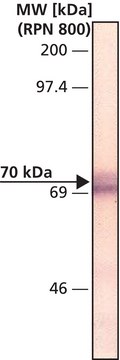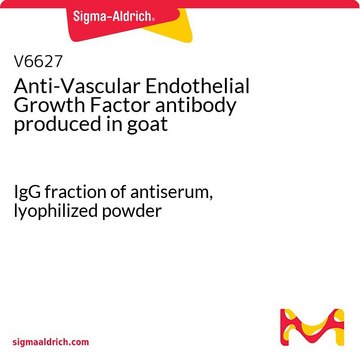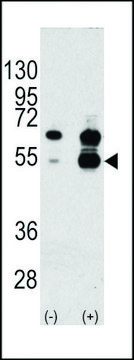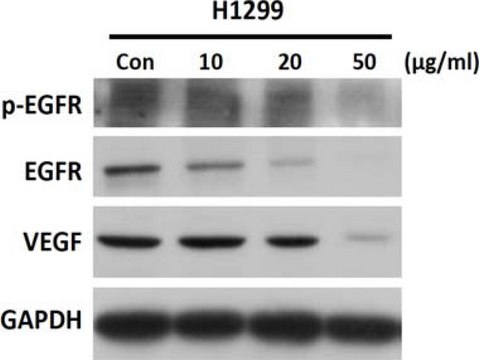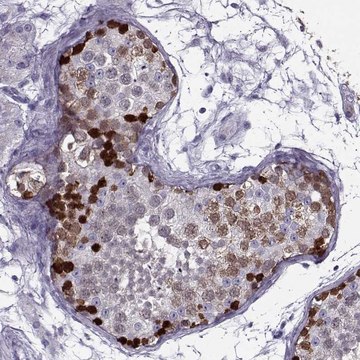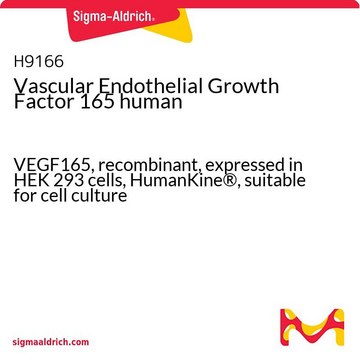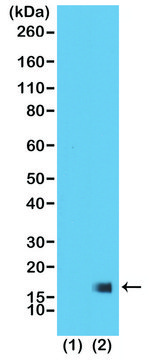V1253
Anti-Vascular Endothelial Growth Factor antibody produced in goat
affinity isolated antibody, lyophilized powder
Synonym(s):
Anti-VEGF
Sign Into View Organizational & Contract Pricing
All Photos(1)
About This Item
Recommended Products
biological source
goat
Quality Level
conjugate
unconjugated
antibody form
affinity isolated antibody
antibody product type
primary antibodies
clone
polyclonal
form
lyophilized powder
species reactivity
mouse
technique(s)
capture ELISA: suitable
immunohistochemistry: suitable
neutralization: suitable
western blot: suitable
UniProt accession no.
storage temp.
−20°C
Gene Information
mouse ... Vegfa(22339)
General description
Vascular Endothelial Growth Factor (VEGF) is a 46kD dimeric, heparin binding glycoprotein. It facilitates several functions like induction of endothelial cell proliferation, inhibits apoptosis, induces permeabilization of blood vessels and promotes cell migration. Anti-Vascular Endothelial Growth Factor antibody can be used for neutralizing the biological activity of recombinant mouse (VEGF164) and recombinant mouse (VEGF120). It can also be used in immunoblotting. Goat anti-Vascular Endothelial Growth Factor antibody reacts specifically with recombinant mouse VEGF.
Specificity
The antibody will neutralize the biological activity of recombinant mouse VEGF164, and recombinant mouse VEGF121. It can also be used as a capture antibody in mouse VEGF 164 or 120 sandwich ELISAs.
Immunogen
purified 164 amino acid residue variant of recombinant mouse VEGF.
Application
Anti-Vascular Endothelial Growth Factor antibody can be used in sandwich ELISAs as a capture antibody in mouse VEGF 164 or 120. It can also be used in immunohistochemistry.
Physical form
Lyophilized from a 0.2 μm filtered solution in phosphate buffered saline with 5% trehalose.
Disclaimer
Unless otherwise stated in our catalog or other company documentation accompanying the product(s), our products are intended for research use only and are not to be used for any other purpose, which includes but is not limited to, unauthorized commercial uses, in vitro diagnostic uses, ex vivo or in vivo therapeutic uses or any type of consumption or application to humans or animals.
Not finding the right product?
Try our Product Selector Tool.
Storage Class Code
11 - Combustible Solids
WGK
WGK 3
Flash Point(F)
Not applicable
Flash Point(C)
Not applicable
Personal Protective Equipment
dust mask type N95 (US), Eyeshields, Gloves
Regulatory Information
新产品
Choose from one of the most recent versions:
Already Own This Product?
Find documentation for the products that you have recently purchased in the Document Library.
Merve Nur Eğlenen et al.
Turkish journal of orthodontics, 36(2), 79-86 (2023-06-22)
Functional treatment of Class II malocclusion is expected to lead to adaptation in the condyle. This study aimed to evaluate the effects of adipose tissue-derived mesenchymal stem cells (ADMSCs), low-level laser therapy (LLLT), and grape-seed extract (GSE) on condylar growth
Hui Wang et al.
Cell cycle (Georgetown, Tex.), 17(17), 2164-2174 (2018-09-11)
The highly malignant feature and difficulties for early diagnosis are the key reasons contributing to the poor prognosis of pancreatic cancer (PC) patients. NFE2L3 is a nuclear transcription factor, which has been reported an important biomarker of several tumors. But
Vascular endothelial growth factor induces cyclooxygenase-dependent proliferation of endothelial cells via the VEGF-2 receptor.
J F Murphy et al.
FASEB journal : official publication of the Federation of American Societies for Experimental Biology, 15(9), 1667-1669 (2001-06-28)
Dorien Reijnders et al.
Physiological genomics, 50(5), 385-392 (2018-03-10)
Preeclampsia (PE), a hypertensive disease of pregnancy, is a leading cause of fetal and maternal morbidity/mortality. Early angiogenic and inflammatory disturbances within the placenta are thought to underlie the development of the maternal PE syndrome and poor pregnancy outcomes. However
Johan Dixelius et al.
Cancer research, 66(4), 2089-2097 (2006-02-21)
Histidine-rich glycoprotein (HRGP) is an abundant heparin-binding plasma protein that efficiently arrests growth and vascularization of mouse tumor models. We have shown that the antiangiogenic effect of HRGP is dependent on its histidine/proline-rich domain, which needs to be released from
Our team of scientists has experience in all areas of research including Life Science, Material Science, Chemical Synthesis, Chromatography, Analytical and many others.
Contact Technical Service